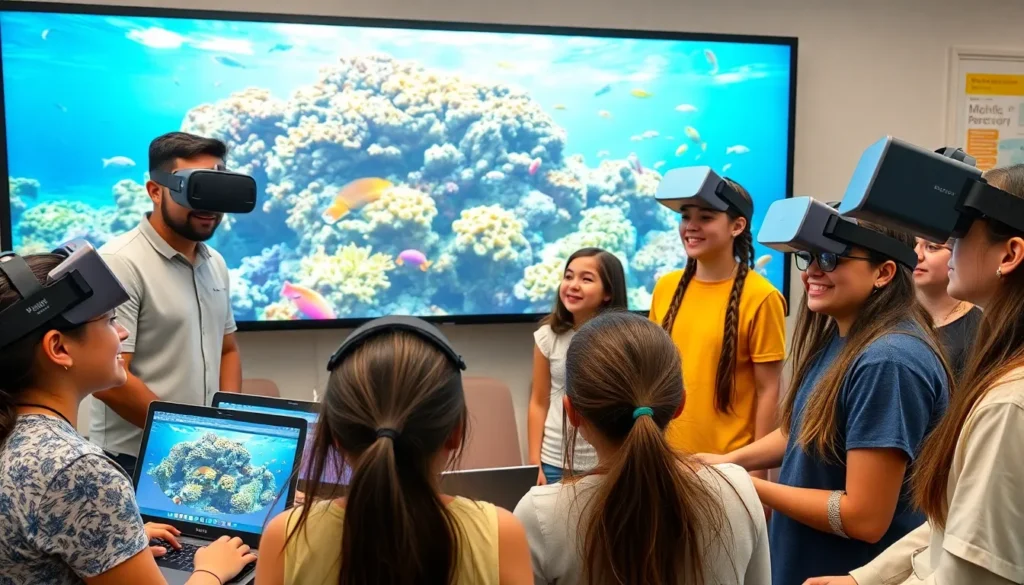Table of Contents
ToggleEducation policies shape the future, but let’s face it, they can sometimes feel as thrilling as watching paint dry. Yet, behind the bureaucratic jargon lies a world of potential that can either launch students into the stratosphere of success or leave them floundering like a fish out of water.
Overview of Education Policies
Education policies encompass the rules, regulations, and guidelines that govern the educational landscape. These policies shape how educational institutions operate and define the roles of teachers, administrators, and students. They impact funding allocations, curriculum standards, and teacher qualifications across various levels of education.
Federal, state, and local governments develop education policies to address specific needs within their communities. Policymakers often consider factors like socioeconomic status, geographic location, and demographic trends when formulating these policies. For example, Title I programs aim to provide additional resources to schools serving low-income students.
Standards-based education reforms focus on ensuring all students meet certain academic benchmarks. This initiative encourages consistency in educational quality across different schools and districts. The No Child Left Behind Act is one of the well-known examples of such a reform, emphasizing standardized testing and accountability.
Teacher preparation policies regulate how educators are trained and licensed. They foster professional development and ensure that teachers possess the necessary qualifications to provide quality instruction. Policies like the Every Student Succeeds Act enable states to create their own educational standards while maintaining accountability measures.
Analyzing education policies highlights their role in promoting equity and access in education. They strive to eliminate disparities in educational opportunities and outcomes for various student groups. The Individuals with Disabilities Education Act mandates that students with disabilities receive appropriate accommodations, ensuring their right to a quality education.
Understanding education policies reveals their dual nature; despite often appearing complex, they hold the power to transform educational experiences. Effective policies equip students with the skills needed to succeed, shaping the future workforce and society at large.
Historical Context

Education policies have a rich history, shaped by key legislation and socio-political changes. Understanding these elements provides a clearer picture of their impact on education today.
Key Legislation Milestones
The Elementary and Secondary Education Act of 1965 marked a significant shift in federal involvement in education. This legislation aimed to close the achievement gap by providing funding to schools serving low-income students. The Individuals with Disabilities Education Act of 1975 ensured students with disabilities received the same educational opportunities as their peers. In 2001, the No Child Left Behind Act introduced high-stakes testing to hold schools accountable for student performance. These pivotal laws transformed the educational landscape, establishing a foundation for future reforms.
Evolution Over Time
Policies have evolved in response to changing societal needs and values. Originally focused on access to education, recent reforms emphasize equity and quality. The introduction of standards-based education reforms aimed for uniformity in educational outcomes across states. Over the past two decades, there’s been a growing recognition of the importance of social-emotional learning alongside academic achievement. As technology advances, policies now also address digital literacy and access to resources. These developments reflect the ongoing commitment to enhancing educational systems for a diverse range of learners.
Current Education Policies
Education policies today shape the framework of the learning environment significantly. The effectiveness of these policies affects students, schools, and communities across the country.
Federal Policies
Federal policies play a critical role in education reform. The Every Student Succeeds Act, for example, replaces the No Child Left Behind Act and emphasizes state control over accountability measures. Funding is also a key component, with Title I providing financial assistance to help low-income schools. Policies focus on enhancing educational equity, ensuring that marginalized students receive necessary resources. Recent initiatives also include support for mental health services in schools. These measures aim to create safer and more supportive learning environments nationwide.
State-Level Initiatives
State-level initiatives complement federal policies, addressing local needs. Many states adopt unique strategies to enhance educational outcomes, such as adopting rigorous academic standards and implementing teacher evaluation systems. Additionally, personalized learning programs have gained traction in various states, allowing students to progress at their own pace. States also engage in professional development for educators, ensuring they are equipped with effective teaching methods. Funding for school infrastructure remains a priority, as quality facilities directly impact student learning experiences. These efforts all contribute to enhancing statewide educational goals and improving student success.
Impact of Education Policies
Education policies significantly affect various aspects of the educational system. Their influence extends to students, teachers, and the overall learning environment.
On Student Achievement
Education policies directly impact student achievement through standardized testing and accountability measures. Schools are often required to meet specific performance thresholds, which can motivate improvement. Evidence shows that policies, such as the Every Student Succeeds Act, enhance support for low-income schools, directly influencing student outcomes. Equity-focused legislation aids underserved populations, fostering an environment where all students can excel. Measurable gains in academic performance often correlate with effective policy implementation.
On Teacher Performance
Teacher performance is influenced by education policies that set standards for training and evaluation. These policies shape professional development opportunities, ensuring educators are better equipped to meet classroom challenges. By mandating rigorous preparation programs, states enhance teaching quality. Additionally, supportive policies encourage collaboration among teachers, further improving pedagogical practices. Effective evaluation systems, which include feedback mechanisms, help teachers grow and adapt to student needs. Teacher retention rates often improve in environments with clear, supportive policies that value educator contributions.
Challenges in Education Policies
Education policies face various challenges that impact their effectiveness and reach. Key issues include funding disparities and persistent equity and access concerns.
Funding Issues
Funding remains a critical challenge in education policies. Many schools struggle with inadequate financial support, directly affecting resources available to students. Limited budgets often lead to larger class sizes, reduced extracurricular activities, and outdated materials. Disparities in funding between districts, particularly between affluent and low-income areas, result in significant differences in the quality of education. States allocate funds based on property taxes, causing a mismatch between needs and available resources. As a result, students in underserved areas face barriers to achieving their potential.
Equity and Access Concerns
Equity and access issues further complicate education policies. Despite legislative efforts, many marginalized groups continue to experience systemic obstacles within the educational system. Students with disabilities, low-income backgrounds, or from minority communities often encounter inequitable access to high-quality education. Programs aimed at enhancing support may lack proper implementation, leading to fragmented services. Additionally, the growing emphasis on standardized testing can inadvertently widen achievement gaps. Ensuring that all students receive equal opportunities for success remains a pressing concern for policymakers and educators alike.
Future Directions in Education Policies
Emerging trends in education policies aim to address the evolving landscape of learning. Innovations shape how institutions respond to diverse student needs.
Innovations and Trends
Digital integration enhances educational access and quality. Virtual learning platforms expand opportunities for remote education. Data-driven decision-making supports personalized instruction and improves curriculum effectiveness. Collaborations with technology firms lead to the development of adaptive learning tools. Mental health initiatives gain traction, ensuring students receive necessary emotional support. Equitable funding mechanisms prioritize resources in underserved areas. This trend demonstrates a commitment to closing the achievement gap.
Policy Recommendations
Targeting funding disparities is vital for further progress. Creating equitable resource distribution models ensures all schools receive adequate support. Advocating for inclusive policies promotes the needs of marginalized communities. Emphasizing social-emotional learning prepares students for real-world challenges. Encouraging community engagement builds stronger connections between schools and families. Supporting teacher development through continuous training enhances educational outcomes. Policymakers must prioritize these recommendations to foster a more equitable educational system.
Education policies play a crucial role in shaping the academic landscape and influencing student outcomes. While they may seem tedious and complex, their impact is profound. By addressing equity access and quality, these policies can create a more inclusive environment for all learners.
As education continues to evolve, the focus must remain on innovative solutions that prioritize the needs of diverse student populations. Policymakers and educators must work collaboratively to ensure that resources are equitably distributed and that every student has the opportunity to succeed.
The future of education depends on the commitment to adapt and improve these policies, ultimately fostering a system that empowers every learner to thrive.










